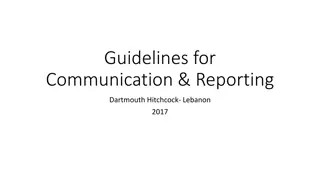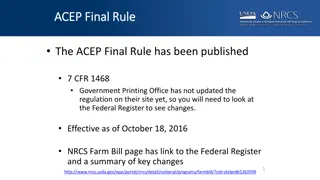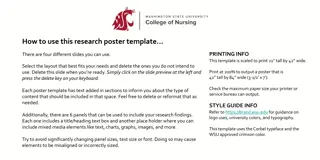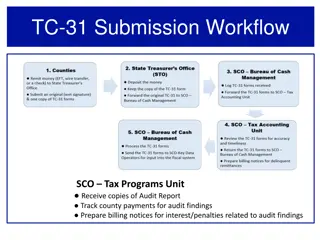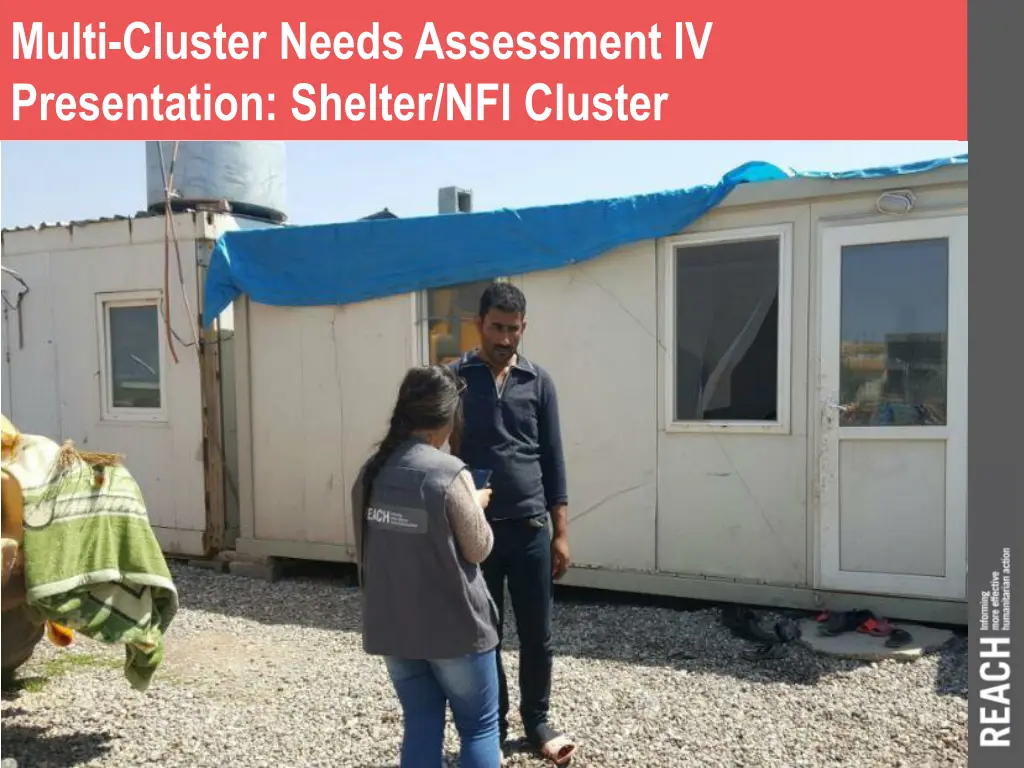
Shelter and NFI Cluster Needs Assessment IV Presentation
Learn about the Shelter and NFI Cluster Needs Assessment IV Presentation in Iraq, focusing on the needs and vulnerabilities of internally displaced populations outside of camps. The assessment methodology, key findings, and next steps are outlined, providing a comprehensive overview of the situation.
Download Presentation

Please find below an Image/Link to download the presentation.
The content on the website is provided AS IS for your information and personal use only. It may not be sold, licensed, or shared on other websites without obtaining consent from the author. If you encounter any issues during the download, it is possible that the publisher has removed the file from their server.
You are allowed to download the files provided on this website for personal or commercial use, subject to the condition that they are used lawfully. All files are the property of their respective owners.
The content on the website is provided AS IS for your information and personal use only. It may not be sold, licensed, or shared on other websites without obtaining consent from the author.
E N D
Presentation Transcript
Multi-Cluster Needs Assessment IV Presentation: Shelter/NFI Cluster
Introduction Contents: Introduction Background Methodology Key Findings Next steps Background Methodology Key findings Next steps
General background to MCNA IV Objective: Cluster-driven process that provides comprehensive evidence base of needs amongst internally displaced populations (IDPs) living in non camp- settings across the whole of Iraq. Introduction Background Type of assessment: MCNAs focus on the needs, perceptions and vulnerabilities of IDPs outside of camps at household level; how they prioritise their needs and view quality of assistance (across all sectors). o Questionnaire includes cluster-specific sections, questions on assistance received as well as self-reported primary needs. o Provides big picture , comparative overview (nation-wide, district and governorate level) based on primary data, for specific sectors. o Ideally used as evidence-base by clusters to guide HNO/HRP process, and complement cluster-driven interventions. Methodology Key findings Next steps Recurring , nation-wide, longitudinal analysis: The MCNA IV is a nation- wide assessment, and will collect comparable data at the district-level in Centre-South for the third time, and for the fourth time in KRI. o Nation-wide scope allows for country-wide comparisons at the governorate and district level. o MCNA is the only assessment which allows for nation-wideanalysis of trends over time (third year in a row).
Background: Overview of MCNA cycle Research design Indicators, forming the basis of the survey tool, are reviewed at the cluster-level ahead of data collection. Introduction Background Methodology Dissemination Data collection Majority of data is collected directly by REACH. For some inaccessible areas partners collect data. Key findings Final output and cluster-specific findings shared with cluster partners including the open access dataset. Next steps Analysis Preliminary findings Preliminary findings presentations are held with all operational clusters Cluster feedback informs in- depth analysis tailored to cluster-specific needs and triangulation of data.
Methodology Iraq wide assessment 18 governorates of Iraq assessed, based on accessibility: 1. Anbar 2. Babylon 3. Baghdad 4. Basrah 5. Dahuk 6. Diyala 7. Erbil 8. Kerbala 9. Kirkuk Introduction 10. Missan 11. Muthanna 12. Najaf 13. Ninewa 14. Qadissiya 15. Salah al-Din 16. Sulaymaniyah 17. Thi-Qar 18. Wassit Background Methodology Key findings Next steps 6,422 households interviewed in total. 78 districts covered out of 109 (72% district coverage). Data collection in Anbar and Salah al-Din supported by Relief International.
Methodology: Assessed Areas Introduction Background Methodology Key findings Next steps
Methodology: Limitations & sampling Some governorates were only partially assessed due to security concerns and authorization issues at the time of assessment. The overall governorate confidence level of 95% applies to those findings which pertain to the full sample. Any findings presented solely on subsets of the population e.g. households who reported that they could not afford basic needs inevitably have a lower confidence level. Household level sampling using random GIS points based off IOM DTM data on IDP population size and respective location in Iraq. Significant results at governorate level, with a 95% confidence level and 10% margin of error. Cluster sampling was employed to help the logistical challenges of collecting nationwide data. Introduction Background Methodology Key findings Next steps
Key findings: Overview 1. Settlement Type 2. Shelter Type 3. HHs sharing 4. Shelter concerns 5. NFI 6. Access to assistance 7. Other relevant findings Introduction Background Methodology Key findings Next steps
Key findings: Settlement type Across the 18 governorates of Iraq 66% of IDP HHs reside in residential housing and 34% are living in critical shelter arrangements (26% in collective centres and 8% in informal sites). Introduction 26% Background Methodology Key findings 8% 66% Next steps Collective centre Informal site Residential housing Southern governorates reported higher results for occupancy in residential housing. While over a third of IDP HHs in the northern and central governorates reported living in collective centres. Collective centre Informal site Residential housing North Centre South 28% 27% 6% 9% 9% 6% 63% 64% 88%
Key findings: Shelter type (Iraq-level) 80% 70% 60% Introduction 50% 40% Background 30% 20% 10% Methodology 0% Abandone d buildingApartment Container 4% 6% 1% 12% Unfinished building 10% 9% House Other School Tent Key findings MCNA III MCNA IV 2% 0% 67% 66% 7% 1% 1% 0% 2% 2% Next steps Comparison of shelter type results between MCNA III and MCNA IV generally show comparable results. occupancy of apartments has doubled. 50% 47% 45% Key shifts include 40% 35% 30% Across Iraq, 6% of IDP households reported living in religious buildings. At the regional level, the highest result was recorded in the south. 25% 20% 15% 10% 4% 5% 0% 0% North Centre South
Key findings: Shelter type by area Houses: In the southern governorates less than half of IDP HHs (46%) are living in houses compared to north (74%) and and centre (62%). For the south this represents a 7% decrease from MCNAIII. Apartments: Occupancy of apartments in the north and centre has doubled since MCNAIII, but has decreased by 5% in the South. Introduction Background Methodology Key findings MCNA III 7% 5% 8% MCNA IV 13% 13% 3% North Centre South Next steps Religious buildings: Highly signficant results for the southern governorates (47%) compared to 4% in centre and negligible results for the north. Unfinished building: The results for south and centre remained exactly the same at 1% and 11% respectively.
Key findings: IDPs sharing shelter At the country-level, 25% of IDP HHs are sharing their accomodation with atleast one other family. This figure has reduced from MCNAIII by 19%. MCNA III Introduction North Centre South 56% Background 50% 42% 42% 40% 33% 26% Methodology 9% 1% Key findings 1 2 to 5 6 or more MCNA IV Next steps North Centre South 82% 78% 70% 30% 21% 17% 1% 1% 0% 1 2 to 5 6 or more Households reporting sharing their shelter with 2-5 families has decreased from 39% in MCNA III to 24% in MCNA IV. In the South there is a significant decreasse by 16% from round III. The centre governorates also shows a significant change from the last round with a decrease of 12%. Households reporting sharing their shelter with 6 or more sharing families highlights a key shift across the regions, specifically in the southern governorates which has decreased from 26% to negligible results.
Key findings: Shelter concerns Across Iraq, 79% of IDP HHs reported that the shelter they are currently occupying is not of adequate quality, which is a 12% increase from MCNA III (67%). Of this 79%, primary concerns reported include too small (45%), leaking roof (34%), broken windows (33%). At country level, the average size of IDP accomodation per family was reported as 2,151m2. Across the country, only 3% reported being threatened with evictions with notably high results in Missan (13%), Anbar (12% and Salah al-Din (8%). Introduction Background Methodology Key findings Next steps
Key findings: Access to NFI items 120% 100% Background 96% 94% 93% 80% Methodology 75% 74% 72% 60% 67% Key findings 52% 40% Next steps 20% 0% Cooking fuel Kitchen set Light after nightfall Access to heating fuel Fuel storage Winter clothes Fan Cool box Cooking fuel Kitchen set Light after nightfall 96% 89% 99% Access to heating fuel 83% 65% 84% Fuel storage Winter clothes Fan Cool box 96% 91% 99% 95% 97% 99% 77% 55% 82% 78% 69% 92% 68% 71% 100% 37% 59% 97% North Centre South
Key findings: Access to Assistance Across Iraq 80% of IDP HHs reported receiving no shelter support in the last 6 months. MCNA IV findings show that 15% of IDP HHs reported receiving Shelter assistance, representing a 5% decrease from MCNAIII. While assistance in the centre and south has remained comparable, it has reduced by 9% in the North from 27% to 18%. When asked about specific shelter support received, the highest reported type was rental support (9%). Over a quarter of IDP HHs in the south received tarpaulin. Introduction Background Methodology Key findings Next steps WASH 1% Electricity Connection 1% Window 2% Door 3% Timber 3% Shading nets 1% Tarpaulin 3% Tent 1% Rental Support 9% 0% 1% 2% 3% 4% 5% 6% 7% 8% 9% 10%
Other relevant findings Across Iraq, 74% of HHs were not able to fully afford all their basic needs. Of these households, 32% reported were not able to afford shelter; this was highest in the north (47%), followed by the centre (22%) and the south (6%). Introduction Background During MCNA III, 47% of HHs across Iraq reported that they could not afford shelter as part of their essential needs. This reduced to 32% in MCNA IV. For the northern governorates results remained comparable but reduced in the south by over 40% suggesting that HHs were increasingly able to afford shelter needs. Methodology Key findings While food was the highest reported reason for HHs taking on debt, rent was the second most reported result (51%) remaining at a similar level to MCNA III (53%). Households reporting taking on debt for rent increased in the centre to 60% compared to 44% in MCNAIII. Next steps Reasons for taking on debt 80% 70% 60% 50% 40% 30% 20% 10% 0% Food Health Education Clothing Rent Business Service bills
Next steps Q & A. Feedback collated from each cluster on findings. Open source: dataset can be disseminated to cluster partners to run own analysis/compare with own findings. Final report compiled and shared in July 2017. Introduction Background Methodology Key findings THANK YOU Next steps Contact: Homera Cheema (Assessment Officer) homera.cheema@reach-intitiative.org Tessa Richardson (Assessment Officer) Tessa.richardson@reach-initiative.org








